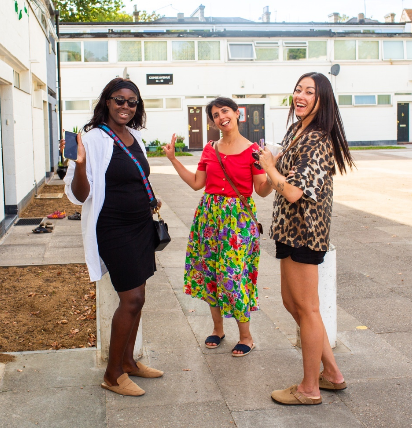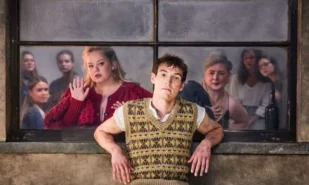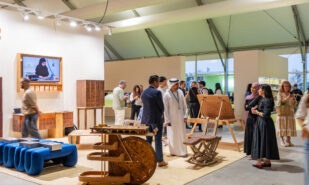Now the two-week long Open House festival has finished in London, which was called “a celebration of architecture and city blocks where you can sneak into some of the world’s most famous buildings, as well as some of its best-kept secrets.” The festival is held annually in September by a community of residents of the capital, who on these days open the doors of their homes to visitors, conduct city walks and excursions. All that is represented through 2,000 events in 700 different locations and, according to the organisers, “is one of the best ways to learn the history of London, its architecture and the social significance of various areas.” London Cult., of course, attended the festival and is ready to talk about everything…
Open House Festival: The City Opens Its Doors!
Morning in the queer spaces of Soho: “the whole truth is not only about romantic relationships.”
On a sunny Saturday, a group of curious listeners, led by the tour guide Imogen, explored queer spaces in Soho’s most famous entertainment district: Piccadilly, Lyons Corner House, The Lyric Pub (formerly known as The Hanyard), Comptons Street, and many others. It’s here, as Imogen assured, you can learn everything “not only about romance and sex, but also about the sense of community and friendship that brings people together and, importantly, activism that was present here even back then.”
The LC was struck by the contrast between the history of Piccadilly and Soho. Imogen explained that back in the 19th and 20th centuries, Piccadilly served primarily as a “gay transactional centre”, with gentlemen’s clubs on every corner. However, if you turn right into the narrow streets of the Strand and Coventry, you will find “a feminised and safe space where queer people could be themselves and… drink tea!” Ted Brown, an activist who helped organise Britain’s first gay pride in 1972, described the area as “a handful of secret gay spots”. And while there’s a lot of work being done in London right now to raise awareness on queer spaces, much of that history is, according to our guide, “still hidden beneath the surface” due to advertising and marketing that prioritises established “cis-male heteronormativity” and misrepresentation of non-binary and transgender people.”
St Martin—in—the—Fields, Trafalgar Square: ‘totally inclusive’
St-Martin-in-the-Fields Church is located right on the corner of Trafalgar Square. Founded in Norman times, and then rebuilt in the 18th century, today it is not only an Anglican church, but also a venue for various events, master classes, and concerts.
As one of the churchwardens, Mel, said, the church prides itself on its atmosphere and community: “What’s unique here is that it’s completely inclusive. We welcome everyone and community is very important to us. Refugees, asylum seekers, and homeless people take part in the projects. That is why so many people are drawn here. For example, we recently hosted 40 Mandarin and Cantonese speakers who came together to support the diaspora and have lunch after the congregation (the Church holds congregations in Mandarin every Sunday).”
Mel also recommended visiting their community garden, a project that was created together with the homeless guests of the church. The public was engaged in gardening with the support of landscape architects FFLO. The project is “designed to make a difference for people experiencing homelessness and improve the well-being of the entire community.”
Two Temple Place: “a fantastic mixture of history and fiction”
The former money-no-object estate, now a museum and cultural centre, sits next to the river Thames and is “an amazing example of neo-Gothic architecture in London”, according to Fay, coordinator of the Two Temple Place programme. It was built by architect John Loughborough Pearson for William Waldorf Astor, a former New York State Representative during his exile from the United States.
Already on the stairs we were greeted by seven mahogany figures, based on “The Three Musketeers” by Alexandre Dumas, and further, on the columns – other famous heroes of American novels, as well as on the ceiling of the Great Hall – a frieze of 54 characters, “glorifying a fantastic mixture of history and literature.” The library was seriously damaged during World War II, but the carvings on the top of the bookcases and the mahogany door remained as designed originally. The building’s stained-glass windows represent “Sunrise” in Switzerland and “Sunset” in Italy, and are the work of Clayton and Bell…
“Hidden Gem” is what Fay called the building. She said that the “Place” has been collaborating with the festival for many years, and this is the second time since the start of the pandemic. “Attendance is amazing, back to pre-Covid levels.” Fay said, “The festival really helps bring in a lot of new visitors,” and reminded that events at Two Temple Place are always free and the budget comes from public donations. Place organises annual exhibitions, collaborates with collections across the country, “trying to make every event and exhibition unique and interesting for the guests.”
Inner Temple Gardens: “even the trees here are protected by law”
Right next to the “Place” are the Inner Temple Gardens. They were founded by the Knights Templar in 1195. And since 1307, this “secret oasis of peace in the heart of the city” has always had a gardener. The gardens survived the Great Fire of London and the Second World War.
Sean, the Head Gardener, told us about what’s special in the gardens, participation in the festival and why people should definitely visit the Inner Temple Gardens:
“We have been cooperating with the festival for the last 3-4 years. The garden is usually open for free on weekdays, from 12:30 to 15:00. What do I like most about the garden? Well, I can say… I love these dahlias! But perhaps one of the most important features is the history of the garden. The archives say that as early as the 13th century, water used to reach the brick buildings around the garden. This means that we, in fact, are now standing on the river, and this is just one amazing fact. The garden is maintained by the Inns of Court, which includes the barristers’ union, the Inner Temple library and Temple Church. I’ve been working here since 2018 and think it’s rare to find such a special garden in London. Inner Temple Gardens are historic, we cannot change their layout, and even the trees are protected by law. I would say the garden is a plant lover’s paradise. It has a unique microclimate due to its proximity to the river and offers stunning views of landmarks such as the London Eye and Big Ben.”
Word to the organisers: “The giddy feeling of entering a place which is usually impossible to enter.”
But how does a festival of this scale actually happen and why is it so important? The event organizers told the LC about this themselves.
Fin Hover, the Chief Executive of the Open House Festival:

“This year’s festival was the most successful since the pandemic. The programme has become much more diverse: we began adding and organising walking tours, speed boats, discussions on the decolonisation of architecture from rising stars Nabil Al-Kinani and Hafsa Adan. This is a huge undertaking for the Open City, which is a fairly small charity. And it’s unlikely that all this would have become a reality without the incredible community of participants and volunteers. I’d say it reminds me of the Fringe Festival even – the celebration that includes hundreds of events organised by contributors on a voluntary basis.
The reaction people have when they enter someone’s home is just magical. There is a dizzying feeling of entering somewhere you would not normally be able to enter. I really enjoy visiting people’s homes, especially now that we are constantly watching and reading different news stories that alienate us from each other. The festival helps fight this alienation.”
Fin themselves appeared as a festival participant and opened their home to visitors at Vanbrugh Park Estate. They said it was great when social housing, such as Alexandra and Ainsworth Estate in Camden and Central Hill Estate in Southwark, opened: “The involvement of these types of housing is very important because social housing tends to have a negative reputation. And because of this, local administrations and government tend to neglect them in terms of funding and maintenance. With Open House, anyone can invite people to visit and tell a completely different, personal story. At these types of events, people learn a lot more about things that no one would normally even notice.”

Hafsa Adan, Assistant Curator:
“It’s really nice to see the photos people post on social media after the contributors open their homes. We have a very small team, and we are all working at the same time. Therefore, this task can be overwhelming, but we do not stop, it still has to be done. The festival could never have become so large-scale if it was not for the full dedication of all contributors and their hospitality.
As the festival grows, new opportunities open up, and the presence of young people in the built environment is particularly significant: in particular, this year the festival received funding for a special “City Curators Programme”, as part of which, over two intense weeks, 15 young Londoners were invited to workshops on creating projects, which were then presented at festival events.
“I think this is really important because it is the youth who will inherit these spaces. The festival should become more useful not only for citizens, but also for professionals, creating a wide network of connections in the built environment, especially for young architects and builders












